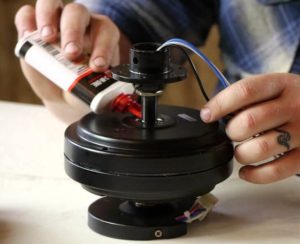Electrical work can create confusion, and I certainly faced many queries while assisting my uncle in wiring my grandmother’s basement. Ceiling fans, like many other aspects of electrical work, can add to the confusion.
In this article, I will have a look at everything you need to know about the red wire in your ceiling fan. The article will give you a detailed and clear description, covering what the red wire is and its various variations. Additionally, I will explore how the red wire differs from the other wires in both the ceiling fan and the house, and explain why it might be a desirable component in your new ceiling fan.
What is the Red Wire in a Ceiling Fan?
The red wire in a ceiling fan serves a specific purpose—it is solely connected to the light. When a ceiling fan has a red wire, it allows independent control of the light and motor using separate switches. Not all ceiling fans will have this red wire. In cases where the red wire is present, it can either be connected or capped off if there is no additional live house wire available.
Red Wire is Typically for Fan Light Control
The red wire in ceiling fans is commonly designed for controlling the fan’s light. This red wire acts as a secondary hot wire, meaning it carries electrical current when the corresponding switch is turned on, and it stops to conduct electricity when the switch is off.
Its primary function is to provide a separate control mechanism for the light component of the ceiling fan. This setup helps to operate the light independently, enabling it to be switched on or off using a separate switch that is distinct from the one used for the fan itself.
Do All Ceiling Fans Come With a Red Wire
No, not all ceiling fans are equipped with a red wire.
The presence of a red wire in a ceiling fan depends on various factors. For instance, some ceiling fans may not have a light fixture at all, eliminating the need for a second live wire.
On the other hand, there are ceiling fans with a light fixture but no red wire. In such cases, both the fan and the light are controlled by a single switch, resulting in simultaneous activation or deactivation.
However, it is worth noting that some ceiling fans may feature pull chains that enable independent control of the light and fan, providing a level of separation in the wiring process.
Why Is a Separate Wire Necessary/Helpful?
While a separate red wire is not necessary for the functioning of a ceiling fan and its lights, it can be a very helpful addition to the wiring setup. However, it’s important to note that there are also some drawbacks associated with it.
It entirely depends on the personal preference of the user to conclude whether it is helpful or not.
Let’s explore the pros and cons so you can assess its benefits for yourself.
Pros of a separate red wire:
- Convenience when multiple light switches are in close proximity to each other
- Independent control of lights and fan enables greater adaptability to different preferences and needs
- If there is a case in which the pull chain breaks, the light and fan can still be operated separately
- Enables the use of different types of switches, such as a dimmer for the lights and a speed controller for the fan
Cons of a separate red wire:
- Inconvenient if the two switches controlling the fan and lights are located far apart from each other
- Not useful if only one light switch is available or can reach the ceiling fan fixture
- May complicate troubleshooting processes when addressing fan-related issues
Is It Different From the Black Live Wire?
While both the red and black wires are considered hot wires that carry electrical current and can be controlled by switches, there are differences between them. The main difference lies in their specific functions within the wiring system.
The red wire, unlike the black wire, is never utilized for the fan motor. In household wiring, colors are designated to different wires to simplify installation and enhance safety. For instance, white wires are consistently used as neutrals, green or bare copper wires serve as grounding wires, and black wires are utilized as live wires.
This color coding system extends to appliances as well, ensuring that corresponding wires match the assigned colors.
In the case of ceiling fans, the primary purpose is to move the fan blades, which is why the fan motor is connected to the standard black live wire. As a result, all ceiling fans come equipped with a black wire, while the presence of a red wire is typically optional.
Alternative colors are assigned to additional live wires to clearly differentiate them from the standard wire trio, making it easier to identify and work with multiple live wires in a wiring system.
Red Wire From Ceiling but Not From Fan
When you see a red wire coming from the ceiling, it indicates a connection to a wall switch. However, if there is no red wire coming from the fan, there are two possible things to consider.
First, it could mean that the fan lacks a second live wire. In this case, you will need to connect the lights and fan motor together. The red wire coming from the ceiling can be safely capped off, as it is not required for the fan’s operation.
Secondly, the absence of a red wire from the ceiling fan may simply mean that the wire is a different color. In some cases, the second live wire on the fan is represented by the color blue instead of red. Functionally, the blue wire serves the same purpose as the red wire. In this situation, you will connect the blue wire and the red wire together.



